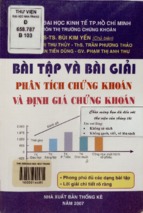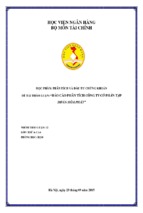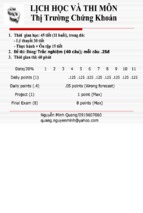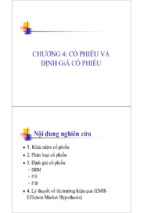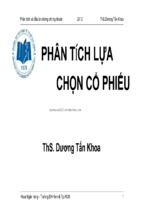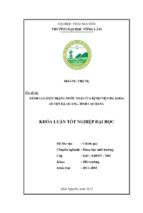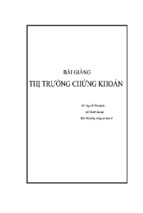Oil Prices and the Stock Market∗
Robert C. Ready†
First Version: September 1, 2012
This Draft: December 13, 2013
Abstract
This paper develops a novel method for classifying oil price changes as supply or demand driven and documents several new facts about the relation between oil prices and
stock returns. Demand shocks are strongly positively correlated with market returns,
while supply shocks have a strong negative correlation. The negative effects of supply
shocks are concentrated in firms which produce consumer goods, and are also strongest
for oil importing countries. Demand shocks are identified as returns to an index of oil
producing firms which are orthogonal to unexpected changes in the VIX index. Supply
shocks are oil price changes which are orthogonal to demand shocks and changes in the
VIX. Theoretical and empirical evidence are presented in support of this strategy.
Keywords: oil prices, stock markets, supply and demand
JEL codes: G01, Q04, E02
∗
I would like to acknowledge the helpful comments of Nikolai Roussanov, Ron Kaniel, Mark Ready, Bob
Jarrow, and seminar participants at Cornell University, The University of Pennsylvania, and the European
Financial Association. All errors are my own.
†
The Simon School of Business - University of Rochester
1
1
Introduction
Over the past three decades, oil prices have received substantial attention as an economic
indicator both from academics and the popular press.1 An extensive macroeconomic literature suggests a strong link between oil prices and economic output. Hamilton [2003] and
others find a strong negative relation between increases in oil prices and future GDP growth,
and Hamilton [2011] points out that 10 of the 11 postwar economic downturns have been
immediately preceded by a significant rise in oil prices.
Given the apparent importance of oil prices, it is natural to examine the relations between
oil prices and other traded assets, such as equities, to help better understand the link between
oil prices and the economy. However in doing this a puzzling fact emerges; oil price changes
and stock market returns seem to be unrelated! Indeed, from 1986 to 2012, a simple regression
of monthly aggregate U.S. stock returns on contemporaneous changes in oil prices suggests
essentially zero relation between the two variables. More simply put: Where is the Oil Price
Beta?2
This finding is particularly surprising when considered in the context of recent macrofinance models featuring long-run risks, following the work of Bansal and Yaron [2004]. These
models have been successful in explaining empirical asset pricing facts using the premise that
expected future changes in personal consumption impact the utility of the consumer today,
and hence have a large contemporaneous effect on the aggregate wealth portfolio and stock
prices. The fact that oil is a strong empirical predictor of macroeconomic growth, including
growth in personal consumption, while having little relation with aggregate stock returns, is
potentially at odds with this intuition.
This paper attempts to address this puzzle by introducing a novel method of classifying
changes in oil prices as demand driven (demand shocks) or supply driven (supply shocks).
The simple intuition behind the identification strategy is that oil producing firms are likely
1
As an illustration, a search for occurrences of the term ”oil price” in the Wall Street Journal from 1986
to 2012 yields 10,821 articles; more than one article per day.
2
This disconnect between the observed importance of oil prices for the macroeconomy and the lack of
stock market reaction to changes in oil prices has received little attention in the academic literature. The
relation between oil prices and stock markets is mostly studied in the context of Vector Autoregressions
(VAR). There is some evidence for relations at various leads and lags, but uniformly weak results in terms of
contemporaneous correlations. See for instance; Jones and Kaul [1996], Kilian and Park [2009], Chen, Roll,
and Ross [1986], Huang, Masulis, and Stoll [1996] and Sadorsky [1999].
2
to benefit from increases in oil demand, but may have a natural hedge against shocks to oil
supply. If oil becomes more difficult to produce, producers will sell less, but at higher prices.
If this is the case, oil producer returns can be used as a control to separate shocks to demand
and supply.
Following this intuition, demand shocks are defined as the portion contemporaneous returns of an index of oil producing firms which is orthogonal to unexpected changes in the
VIX index, which are included to control for aggregate changes in discount rates.3 Supply
shocks are constructed as the portion of contemporaneous oil price changes which is orthogonal to demand shocks as well as to innovations in the VIX.4 By construction, innovations
to the VIX (henceforth risk shocks), demand shocks, and supply shocks, are orthogonal and
account for all of the variation in oil prices. Since the VIX has very low correlation with oil
prices, nearly all of the variance is captured by the demand and supply shocks, with supply
shocks accounting for 78.5% of the total variation and demand shocks another 20%.
When the supply and demand shocks are examined separately, it becomes clear that the
apparent lack of relation between oil prices and stock returns is an artifact of the conflicting
effects of the two types of shocks. Instead of no relation, both supply and demand shocks
are strongly correlated with aggregate stock returns over the sample period. Changes in
oil prices classified as supply shocks have a strong statistically significant negative relation
with stock returns, with oil supply shocks explaining roughly 4% of the monthly variation
in aggregate U.S. stock market returns over the 1986 - 2011 sample period. The presence
of large outliers of returns during the financial crisis increases this to roughly 9% when the
sample is restricted to the period prior to June 2008, with nearly all of the effect coming
from 1985 - 1992 and 2003 - 2008, two periods of high uncertainty in oil markets. Similar
results hold for international stock returns, with the impact of supply shocks being strongest
for oil importing countries.
In contrast, increases in prices classified as oil demand shocks have a strong positive
relation with stock returns, and explain roughly 10% of monthly U.S. stock market variation
over the time period. Demand shocks are significantly positively correlated with both U.S.
3
Unexpected innovations are the residual from an ARMA(1,1) regression.
Returns to a position in short-term oil futures are used to focus on the unanticipated change in the oil
price.
4
3
and world returns in all subperiods, with the exception of a weak correlation with U.S.
returns during the 2003-2008 period. However, during this period the demand shocks are
still strongly positively correlated with world returns, suggesting world wide growth as the
source of increases in demand over this period.
In addition to providing evidence for the importance of oil in explaining aggregate stock
returns, construction of these shocks also allows for an investigation of how oil shocks affect
different types of firms. Regressions of industry portfolios find that all industries, with the
exception of gold and coal producers, have significantly negative relations with oil supply
shocks. However, it is not the industries with the highest oil use that are the most negatively
affected by oil supply shocks. While some high oil use industries such as Airlines are near
the top of the list, in general producers of consumer goods and services (ie. Apparel and
Retail) tend to have greater exposures than high oil use manufacturing firms. This result
suggests that the main effect of an oil shock may be a reduction in consumer spending,
which in turn impacts firms that produce consumer goods, consistent with the hypothesis
of Hamilton [2003] that oil shocks act through a reduction in consumer demand. The least
impacted firms appear to be high tech and telecom firms, which have low oil use and may
be less directly dependent on consumer spending. All industries have positive betas on oil
demand shocks, with high oil use industries having the strongest loadings. High oil use firms
tend to be manufacturing firms, suggesting that increases in manufacturing activity may be
the primary driver of oil demand shocks.
The interpretations here rely crucially on the validity of the identification strategy. To
understand the logic, it is important to understand the potential reason for the lack of
correlation between oil prices and stock prices. If an exogenous increase in oil prices is,
ceterus paribus, bad news for stock prices, what possible cause is there for the negligible
relation between the two variables? One potential explanation is an omitted variable, with
an obvious candidate being shocks to aggregate oil demand, which would intuitively be
associated with rising oil prices and positive equity returns.5 In order to account for this
5
This logic has been emphasized by several authors, most notably Kilian [2009]. A different logic, suggested
in recent work by Casassus and Higuera [2013], builds on the fact (se Driesprong, Jacobsen, and Maat [2008]
and Casassus and Higuera [2012]) that high oil prices predict low future aggregate market returns. If high oil
prices mean low future cash flows but also lower expected future returns, the two effects can also counteract
each other when examining stock market returns. It is shown here that the identified supply and demand
4
and sign the causal relation between oil prices and stock returns, one might potentially find
instruments for oil price changes that are exogenous with respect to the rest of the economy,
such as a time series of events affecting oil production.6 However these events tend to be rare
so this technique is less suited to answering the question of how much the variance in stock
prices is driven by oil supply shocks.
Another potential issue with directly classifying shocks lies in the definition of a supply
shock. Although oil supply shocks are typically thought of as discrete events, such as a war
or hurricane which disrupts oil production, there is the possibility for more subtle effects.
For instance, how would one classify a month where oil prices rise slowly day by day, as the
amount of oil produced fails to meet expectations? The resulting change in prices is as much
a supply shock as a one time major disruption in production from a natural or political event,
but is much more difficult to identify from news reports.
Perhaps the most direct technique to account for this problem is to examine data on
oil production. Kilian [2009] attempts to disentangle demand and supply shocks using a
structural vector autoregression (SVAR) with data on oil production and shipping activity
as proxies for supply and demand, and Kilian and Park [2009] extend this methodology
to examining different shocks’ impact on the U.S. stock market. However, they find very
little contemporaneous explanatory power (less than 2% combined), mostly concentrated in
changes in oil prices related to neither supply nor aggregate demand.
One weakness of this framework is that the data included in the SVAR needs to correlate with contemporaneous or future changes in oil prices to effectively identify shocks. For
instance, the identified supply and demand shocks in Kilian [2009] explain only 2% of the
contemporaneous variation in oil prices from 1987 to 2011, and less than 1% one percent when
the sample is truncated in 2008 to remove effects of the financial crisis. Of the remaining
variation in oil price changes, 30% is classified as predictable by the VAR, suggesting overfitting, and the remaining 68% is classified as ”precautionary demand shocks”.7 Unfortunately,
there is no way to ascertain if these changes in precautionary demand are driven by concerns
shocks both predict negative future market returns, suggesting that their difference in correlations with
contemporaneous market returns is not driven by discount rate effects.
6
This strategy is pursued by several authors, including Hamilton [1983], Hamilton [2003], Kilian [2008],
and Cavallo and Wu [2006].
7
See Web Appendix section ??.
5
over supply or expectations of changes in demand. For example, an increase in oil prices
driven by concerns over a supply constraint which never materializes will not be captured
in the VAR, since production will not respond, and will thus be classified as precautionary
demand. In contrast, an increase in prices due to expected increases in demand receive the
same classification, and presumably the two events will have markedly different effects on
aggregate returns. An identification technique, such as the one presented here, which relies
upon prices of traded assets can make use of the forward looking nature of prices to avoid
these issues.
To provide motivation for the identification scheme used here, a theoretical model of a
competitive commodity producing sector is introduced, similar to the exhaustible resource
models of Carlson, Khokher, and Titman [2007] and Casassus, Collin-Dufresne, and Routledge [2005]. The model provides evidence that certain characteristics of commodity production, namely the depletable nature commodity resources, the highly inelastic demand,
and the significant difficulties in developing new reserves, give oil producers a natural hedge
against shocks to the aggregate productivity of the sector. This in turn will yield producer
stock returns that are unresponsive to changes in the productivity of the sector. This lack of
response to these supply shocks makes producer returns an effective control for identification.
The supply and demand shocks in the model are essentially cash flow shocks, in that they
effect the earnings of oil producers. In order to examine discount rate effects, the model also
includes exogenous changes in the price of risk associated with demand shocks, and shows
that these changes impact producer stock returns without impacting oil prices. Since these
shocks are likely to have an effect on aggregate stock prices, neglecting to control for them
can lead to a negative correlation of identified supply shocks with the market index even
in the absence of any relation between oil prices with aggregate returns. This motivates
the inclusion of innovations to the VIX index as a control in the empirical identification
technique, since these innovations have a strong negative correlation with both the aggregate
market and oil producer returns.8
The model shows that the identification technique is plausible, empirical evidence is also
8
An extensive recent literature relates volatility and the variance risk premium embedded in the VIX to
discount rates and stock market returns. See ?, ?, Drechsler and Yaron [2011], and Bollerslev, Tauchen, and
Zhou [2009] as examples.
6
provided to show that the constructed variables are effective proxies for supply and demand
shocks, and that the impacts on the aggregate market return are indeed driven by shocks to
oil prices. One test of this is to look at the comovement of the volatilities of the variables
used in the identification. A well known fact about oil prices is that their volatility is highly
correlated with the volatility of the stock market.9 This result is difficult to explain if shocks
to oil prices have no impact on aggregate stock returns. However, if the stock market’s
response to supply shocks is offset by its response to demand shocks, an increase in the
volatility of either shock will generate an increase in stock market volatility. It is also shown
here that the volatilities of oil producer stock returns appear to have little relation with oil
price volatilities. The fact that increases in the volatility of oil prices are associated with
rises in aggregate market volatility while having no effect on oil producer return volatility
suggests that oil producer returns are uncorrelated with an important component of oil price
changes, precisely consistent with the story here.
As a further test, the same exercise is also conducted with copper and aluminum, two
other commodities that are easily storable and are inputs to production, but whose prices
are presumably less likely to have a major impact on aggregate output. If the channel
for the results is unrelated to oil price shocks, one would expect similar results for these
commodities. Instead, while the demand shocks for these two commodities are highly related
to the aggregate stock market, the identified supply shocks have a negligible relation to
aggregate stock returns.
Finally, regressions are used to directly test the impact of the identified shocks on variables
relating to macroeconomic output and the U.S. oil supply, and the results are consistent with
the supply shock interpretation. The identified supply shocks are negatively correlated with
current and future economic output and as well as current levels of oil consumption and
production. Conversely the identified demand shocks positively impact current and future
aggregate output, and to the extent they impact levels of oil consumption and production it
appears to be in the form of predicting a delayed increase in both variables, consistent with
the behavior in the model.10
9
See Sadorsky [1999] and Malik and Ewing [2009].
Though the model does not explicitly include storage, the supply shocks also correlate strongly with
inventories, resulting in marked decreases in U.S. inventory levels, which is intuitively consistent with the
10
7
The rest of the paper is organized as follows: Section 2 introduces a basic model of
competitive oil producers and discusses the shock identification strategy in the context of the
model. Section 3 empirically implements the identification strategy, presents the relations
between the shocks and the aggregate stock market, and presents empirical support for the
validity of the identification technique. Section 4 presents detailed results on the relations
between the two constructed shocks and domestic and international stock markets. Section
5 concludes.
2
A Simple Model of Oil Production
The basic model introduced here is a model of atomistic competitive firms which take the price
as given and choose both investment in oil reserves (with very high adjustment costs) and the
level of a flow input (with low adjustment costs). The model is very standard when compared
with previous models of commodity production, such as Kogan, Livdan, and Yaron [2009],
Casassus, Collin-Dufresne, and Routledge [2005], Carlson, Khokher, and Titman [2007], and
Ghoddusi [2010]. The benchmark model views oil as a depletable resource as in Carlson,
Khokher, and Titman [2007] and Ghoddusi [2010]. The first important extension here is the
inclusion of exogenous supply shocks, in addition to the standard demand shocks, so that the
relative impacts on prices and producer stock returns can be examined. The supply shocks
are modeled as increases to the flow of oil produced by a given level of flow input and oil
wells. These shocks both increase current production as well as the speed with which oil
wells are depleted.
Given the highly inelastic demand for oil (Cooper [2003] and Ready [2013]), the model
shows that the depletable nature of oil can create an industry whose returns are unresponsive
to changes the exogenous supply shocks. This unresponsiveness is the property that allows
for the identification of the different shocks using producer returns.
The model also deviates from existing work in allowing for exogenous shocks to the expected rate of return on oil producing firms, which in the model is generated by an exogenous
shock to the price of risk associated with aggregate demand shocks. These shocks impact oil
explanation.
8
producer returns without affecting oil prices, and therefore need to be controlled for in order
to effectively identify demand and supply shocks.
The model does not explicitly describe a claim to an aggregate stock market. While
it would be simple to include a reduced-form specification of an aggregate market return
which would match the observed correlations between aggregate returns on the shocks to the
oil industry, this would not provide any additional insight. A more complete model would
specify final goods producers which would use oil as an input to produce goods for sale to
consumers, but since the main goal here is to provide support for the identification technique,
such a model is beyond the scope of the current project.
2.1
Firms
The model consists of a continuum of competitive firms with standard Cobb-Douglas production technology.
(1)
Ot = Zt Ftν Wt1−ν
Oil wells Wt , and a flow input Ft , are used to produce oil output Ot . The level of
productivity is also affected by an oil industry production shock, Zt .11
In the context of the model, Wt represents oil reserves in the ground. This is an important
distinction which is unique to a commodity producer, and helps to capture the storable nature
of commodities. The costs of increasing production in a given period are not only the direct
costs to the producer of a higher level of the input Ft , but also the reduction of oil reserves
available to produce in future periods.12 This cost is reflected in the evolution of oil reserves
(2)
Wt+1 = Wt (1 − δ) − d × Ot + It
11
For simplicity, it is assumed that there are no firm specific shocks, as well as no entry and exit.
This feature is central in the exhaustible resource model of Carlson, Khokher, and Titman [2007], and
also present in the production model of Casassus, Collin-Dufresne, and Routledge [2005]
12
9
The producer chooses investment in new reserves (It ) , which are depleted both from
depreciation, δ, and from the production of oil multiplied by a depletion rate d. The case
where d = 1 will be referred to as the ”Benchmark Model”, and the case where d = 0 as the
standard ”Neoclassical Model”.
Given an oil price, Pt , firms sell their output earning a profit Πt
Πt = Pt Ot − cF Ft − It − Φ(Ft , Ft−1 , It , Wt )
(3)
Here Φ is a function representing costs to adjusting both the level of the flow input and
the levels of investment in oil wells, and has a standard quadratic form
aF
Φ(Ft , Ft−1 , It , Kt ) =
2
(4)
�
Ft − Ft−1
Ft−1
�2
aW
Ft−1 +
2
�
�2
I¯
I
−
Wt
Wt W̄
Where I¯ and W̄ are the deterministic steady-state values of investment and oil well
stock, and aF and aW govern the level of adjustment costs for the flow input and oil reserves
respectively. The producers take the price as given and solve the maximization problem
(5)
max =
X∞
t=0
Ft ,It
Mt Πt
Where Mt is the stochastic discount factor.
2.2
Consumers
Since the model does not include a separate competitive storage sector (see Routledge, Seppi,
and Spatt [2000] and Williams and Wright [1991]), consumers consume all of the oil output in
each period. Instead the storable nature of oil is captured in the producers’ choice between
producing now and saving reserves for future production, and captures some of the same
intuition as a separate storage technology.
Following Kogan, Livdan, and Yaron [2009], consumers of oil are represented by an inverse
10
demand curve, so that spot prices Pt are given by
1
Pt = At (Ot )− α
(6)
The price is dependent upon At , representing the aggregate level of oil demand in the
economy, Ot , the total production of oil, and α, the elasticity of demand.
2.3
Dynamics
From equation (6) it is clear that there are two possible channels in the model for generating
a change in the oil price. The first is a rise in the level of demand At , and the second is a
reduction in the level of supply Ot . Though producers of final goods and household consumers
are omitted for parsimony, simple intuition suggest that rises in the oil price from increases
in At reflect positive economic news, while rises in price from a reduction in Ot generated by
a decrease in productivity, Zt , would represent negative news for the aggregate stock market.
Both aggregate oil demand and oil productivity are stochastic and their logs (indicated
by lower case) evolve according to
(7)
at+1 = a0 + ρa (at − a0 ) + σa ea,t+1
(8)
zt+1 = z0 + ρz (zt − z0 ) + σz ez,t+1
Where ea,t+1 and ez,t+1 are independent normally distributed shocks with mean zero and
a variance of one. High realizations of either ea,t+1 or ez,t+1 correspond to ”good” times, and
therefore both command positive prices of risk. To capture this the stochastic discount factor
is given by
(9)
Mt+1
= β exp(−λa,t ea,t+1 − λz ez,t+1 )
Mt
Where λa is time varying and evolves according to
11
λa,t+1 = λ¯a + ρλ (λa,t − λ¯a ) + σλ eλ,t+1
(10)
2.4
Model Results
A competitive equilibrium is defined as a sequence of choices of It and Ft such that the
firms are maximizing firm value while taking Pt as given, and the market clearing condition
1
−α
Pt = At Ot
is met.
The model is solved numerically, but the main intuition regarding the identification result
can be seen in the producers’ first order equation for the choice of the flow input, Ft
(11)
cF = ν
Ot
(Pt − d × qt )
Ft
Where qt is the lagrangian multiplier associated with oil well accumulation, and represents
the marginal value of an extra oil well in time t + 1.
In the standard neoclassical framework (d = 0), inelastic demand (α < 1), and high
adjustment costs on oil reserves Wt mean that a positive productivity shock is detrimental
to producers. The increase in output from higher well productivity Zt yields a decrease in
price and a drop in revenue. The competitive firms reduce the level of the adjustable input
in response, but the decrease in the input is not enough to counteract the fall in price and
therefore results in a reduction in profit.
In the Benchmark Model (d = 1), the competitive producers will take into account that
selling at the current low price is costly since prices are expected to increase in the future. This
effect is a standard feature of exhaustible resource models, dating back to Hotelling [1931].
Therefore the drop in price Pt will come along with a rise in the value of qt . Accordingly, when
faced with a positive productivity shock, the producers will respond with a more aggressive
decrease in the level of the adjustable input. The resulting additional decrease in output leads
to higher prices in equilibrium, and for reasonable parameters the fall in price will offset the
increase in productivity and oil productivity shocks will have little effect on producer stock
12
returns.
2.5
Simulations
The model is solved for a benchmark case, with parameters given in Table 1, as well the
standard neoclassical case where there is no depletion of reserves from production (d = 0).
The important parameter for the identification technique is the elasticity of oil demand,
which is significantly less than one in the data. The calibration uses a value of α = 0.5,
consistent with estimates in the literature (See Kogan, Livdan, and Yaron [2009] and Ready
[2013]). The remaining parameters are calibrated to match volatilities and correlations of
prices and returns.
[Table 1 about here.]
To illustrate the mechanisms in the model, Figure figure 1 shows impulse response for the
two shocks in each of the two cases. The first column of plots represents the response of four
model variables to an oil demand shock. An increase in oil demand generates an increase in
oil prices, an increase in oil production, and increased use of the oil flow input by producers.
In both cases there is also a positive impact on the value oil producing firms and hence the
stock return.
[Figure 1 about here.]
The second column shows the outcome of a decrease in oil well productivity, Zt . Again,
the oil price rises along as production falls, however this time some of the fall in production is
offset by an increase in the flow input. This effect is much more pronounced in the benchmark
case, as producers compete to produce oil in the time of high prices, before reserves rise and
lower prices again. This increase in production is enough to prevent a rise in profitability or
value for producers, and hence there is no positive stock return.
Table ?? reports calibrated volatilities and the correlation of oil producers’ stock returns
and changes in oil prices for both the simulated model and the data. The table also reports
the correlations between the simulated price innovations and returns and the unobservable
supply and demand shocks. The oil producer stock returns are essentially perfectly correlated
13
with demand shocks while being nearly uncorrelated with supply shocks, making them an
effective control for identifying the two unobserved sources of variation.
[Table 2 about here.]
Though the model is meant to be stylized, it does provide some insight into how an
empirical identification technique should work. A positive supply shock should be reflected
in lower prices, and higher oil output, while a positive demand shock should be reflected in
higher prices, and potentially a rise in oil production, but not one as marked as the observed
decrease from the supply shock. The differential exposure of oil producer returns to the two
types of shocks also allows for identifying the source of changes in price.
3
Identification of Oil Shocks
3.1
Data and Shock Construction
The three variables necessary to construct the series of supply and demand shocks are an index
of oil producing firms, a measure of oil price changes, and a proxy for changes in expected
returns. To cover as much of the global oil industry as possible, the index used is the World
Integrated Oil and Gas Producer Index available from Datastream. This index covers the
large publicly traded oil producing firms (Exxon, Chevron, BP, PetroBrazil, PeMex, etc..),
but does not include nationalized oil producers such as Saudi Aramco. For changes in the
oil price, the one-month return on the nearest maturity NYMEX Crude - Light Sweet Oil
contract are used for the bulk of the analysis, in order to focus on unexpected changes to oil
prices. Aggregate U.S. stock market data is from the universe of CRSP stocks.
13
To proxy for changes int the discount rate, innovations to the VIX index are used. The
VIX is calculated from options data, and therefore provides a measure of the risk-neutral
expectation of volatility. Not only is the variable forward looking, an extensive literature
has shown that the changes in the variance risk premium captured in the VIX are both
strongly negatively correlated with stock returns and positively predict stock returns in the
13
Appendix ?? discusses the data sources and explores the results using other sources of oil producer
indices, oil prices, and risk levels, and the effects of controlling for aggregate levels of prices and exchange
rates. There is no significant impact on the results.
14
time series, suggesting that it may be a reasonable proxy for changes in risk. The VIX is
published by the CBOE for going back to 1986, and this limits the data for the main portion
of the analysis.14 In order to isolate unexpected changes in the VIX, an ARMA(1,1) process
is estimated the residuals from this process are used as innovations. These innovations are
denoted ξV IX .
[Table 3 about here.]
Panel A of Table 3 provides summary statistics of standard deviations and correlations
of the four variables for the sample period. This correlation matrix is at the heart of the
strategy pursued in this paper. The high correlation between oil producer returns and both
oil prices and aggregate market returns, along with a very low correlation between oil prices
and aggregate market returns, suggests that there may be some source of variation which
loads negatively on aggregate stock returns but positively on oil prices and is uncorrelated
with producers, perfectly consistent with the productivity (supply) shocks in the model.
Additionally changes in the VIX seem to have a strong impact on both aggregate and oil
producer stock returns, but a minimal impact on prices, suggesting that it is important to
control for these changes when exploring how changes in oil prices impact stock prices.
For the primary analysis the supply shocks st , demand shocks dt , and risk shocks vt are
orthogonal and defined using the the system
∆pt
P rod
Rt
ξV IX,t
1
1
1
= 0 a22 a23
0
0 a33
st
dt
vt
Panel B of Table 3 shows the summary statistics for the constructed shocks. The annualized volatility of changes in oil prices over the sample period is roughly 33.8% while
the annualized volatility of the supply and demand shocks is 30.5% and 15.6% respectively.
Equivalently, roughly 78% of the variance in oil prices is classified as supply shocks, 20% is
classified as demand shocks, while the shocks to the V IX explain on 1% of the total variance
14
The CBOE changed methodology in construction of the VIX in 1990. The series here is constructed
using the new ”Model Free” method going back to 1990, and the older method prior to 1990.
15
in oil price shocks, though they are important for the identification since they are highly
correlated with producer returns.
3.2
Oil Shocks and Aggregate Stock Returns
Once the shocks are constructed, it is a simple matter to use them in a basic regression of
aggregate stock market returns.15 Table 4 reports regressions of the form
(12)
RtM kt = α + βd dt + βs st + βV IX ξV IX,t
as well as univariate regressions of the market return on each shock, for both the aggregate
CRSP stock index and a world wide stock index from Global Financial Data. On their own,
oil prices have little or no relation to aggregate market returns. However, when they are
decomposed into two series, which together explain nearly all of the variation in oil prices, oil
prices have a very clear and intuitive link to the stock market. High oil prices from supply
shocks are bad news for aggregate stock returns, and can explain 4% of the monthly variation
in the aggregate market return, and rises in prices from demand shocks are associated with
positive excess returns and can explain an additional 10% of the aggregate variance.
[Table 4 about here.]
One potential issue with oil prices, as noted by Hamilton [2003], is that large movements
tend to be the drivers of statistical results. To address this Figure 2 shows scatter plots of
monthly returns against the realizations of the two shocks against U.S. stock market returns.
Although there are some outlying large supply shocks accompanied by negative returns (these
tend to be from the gulf war period), the most noticeable outliers are the highly negative
returns of the 2008 financial crisis, which go against the general pattern.16
[Figure 2 about here.]
15
Since the risk shocks vt , are simply a scalar multiplied times ξV IX,t , ξV IX,t is used in the regression in
order to provide a more straightforward interpretation of the economic magnitude of the regression coefficients.
16
Table 8 reports results for the supply shock regressions restricting the sample to the period prior to the
financial crisis. Doing so provides a marked increase in the R2 of the supply shocks, from 4% to 9%.
16
3.3
Evidence for Validity of Identification Technique
It is clear that decomposing changes in oil prices in the manner described in the previous
section leads to strong correlations with aggregate stock market returns. In order to defend
the proposed interpretation that this decomposition allows for identification of supply and
demand shocks, several methods are pursued. Section 3.3.1 examines the behavior of producer
returns and prices around a known supply shock, the first Gulf War, and finds them to be
consistent with the story. Section 3.3.2 looks at the relation between stock market volatility
and oil price volatility, and finds a strong positive correlation between oil price volatility
and aggregate stock market volatility, but a negligible relation between oil price volatility
and oil producer return volatility, suggesting that oil producer returns are unrelated to an
important component of oil prices. In Section 3.3.3, the same exercise is pursued with
two other commodities, aluminum and copper. There the identified supply shocks have
little relation with returns, providing evidence that the result is not an artifact of a purely
mechanical relation between producer returns and commodity prices. Finally, in Section
3.3.4 analysis is presented which shows that the two shocks relate to variables reflecting
macroeconomic output and the oil supply in ways which are consistent with the supply shock
interpretation.
3.3.1
Oil Producer Returns and Oil Prices
To defend the validity of this technique, as a first step it is instructive to study the behavior
of oil producer returns and oil prices around an observable shock to oil production. Figure 3
gives an example of this using the first gulf war.
[Figure 3 about here.]
In the first panel, the stock prices of several multinational oil producing corporations are
shown along with the spot price of oil during the first Gulf War. Companies active in the
Middle East, such as Ashland, Inc. and Occidental Petroleum, suffered drops in value due
to concerns about their ability to produce during the conflict. In contrast companies, such
as British Petroleum, which were not operating in the region, saw their valuations rise with
the higher price of crude.
17
The second panel shows the behavior of the Datastream World Integrated Oil and Gas
Producers index over this period, as well as the performance of the U.S. stock market. The
initial invasion of Kuwait saw a spike in oil prices, and a negative return for the aggregate
stock market, but very little response in the returns of oil producers.
Although some individual producers saw large changes in price, it appears that in aggregate the lower total production and higher price offset, so that oil producers as an industry
enjoyed a natural hedge against the potential supply shock. At the same time, aggregate
stock values fell, suggesting a potential relation between changes in oil prices and stock
returns.
3.3.2
Stock Market and Oil Price Volatility
Another piece of evidence that supports the story put forth here is the relation between stock
market volatility and oil price volatility. If supply shocks and demand shocks have conflicting
effects on returns, yielding low correlation when considered together, there should still be a
strong positive correlation between the volatilities of oil prices and aggregate market returns.
If the volatility of either demand shocks or supply shocks increases, this will yield higher
volatility in both aggregate stock market returns and oil prices. This positive correlation
has been previously documented by Sadorsky [1999] and others, and is confirmed here. A
new fact, shown here, is that the relation between oil price volatility and oil producer return
volatility is negligible. This is potentially puzzling but easily explained in the context of
the identified shocks. If all of the time series variation in oil price volatility comes from the
supply shocks, then there will be no relation between oil producer stock return volatility and
oil price volatility, precisely consistent with the data.
[Table 5 about here.]
Table Figure 5 the results from four pairs of regressions using monthly observations of
volatility for each of the three variables constructed using daily returns as in Schwert [1989].
The first two columns shows regressions of contemporaneous changes in market volatility
and oil producer return volatility on contemporaneous changes in oil price volatility over the
whole 1987 - 2012 sample period. One period lags of differences and levels are included to
18
control for predictable changes in volatilities. The second two columns repeat this for the
pre-crisis data sample. In both samples there is a strong contemporaneous relation between
spot price volatility and aggregate market volatility, but no relation between the volatility
of oil producer returns and oil prices. This is very strong evidence that a portion of oil price
changes has no effect on oil producer returns while having a significant effect on the aggregate
market. The last four columns repeat this in levels, and find qualitatively the same result.
The large increases in volatilities during the crisis create a mildly significant relation between
levels of oil price and oil producer returns volatilities, but this complete disappears once the
crisis period is dropped.
3.3.3
Copper and Aluminum Producers and Prices
The regression results in Table 4 provide evidence that there may be a strong relation between
oil supply shocks and aggregate stock returns. However one potential concern is that the
results may be driven by a shock common to aggregate stock returns and oil producer returns,
which has no effect on oil prices. However, if this is the case, it is reasonable to think that
such an effect would be generated regardless of the commodity being examined.
Table 6 shows summary data for variables and shocks constructed using the same method
as in Table 3, but substituting producer indexes and price changes for copper and aluminum.
These two commodities are chosen because they are storable inputs to production, and world
wide stock index data for the specific industry is available. The correlations and volatilities
are similar to those observed for oil prices and producer returns, except that the correlation
of commodity prices and aggregate market returns is more strongly positive for copper and
aluminum than for oil, potentially because supply shocks to these commodities have less of
an impact on the economy.
[Table 6 about here.]
Tables 7 repeat the regressions of aggregate market returns on the constructed shocks
and the results suggest that this is the case. Second, loadings on the supply shocks are
not statistically significant, and the R2 increases are negligible. Since the primary difference
between oil and the two metal commodities is the unique status of oil as the most important
19
input commodity for economic output, this result suggests that the driving effect for the
patterns in the oil regressions are supply shocks and not some other omitted variable.17
[Table 7 about here.]
3.3.4
Macroeconomic Variables and Oil Shocks
While the results from regressions of market returns is suggestive of the supply shock story
being proposed here, it is important that the identified shocks have an impact on real economic variables, particularly those related to the oil market.
To quantify these impacts univariate vector autoregressions (VARs) are estimated for
macroeconomic variables, with the constructed supply and demand shocks entering as exogenous variables. Following Hamilton [2008], these VARs have the following form18
(13)
∆yt =
XN
n=1
βny ∆yt−n +
XN
n=0
βns ∆st−n + βnd ∆dt−n
�
Where yt is the log of an economic variable of interest, and st and dt are the innovations
to the supply and demand indices as described in the previous section. These indices are
included contemporaneously as well as with N lags.
Since U.S. data for both aggregate output and oil use is readily available for the sample
at issue, I first focus on a set of five variables related to U.S. economic output and oil consumption. The two variables designed to capture the level of aggregate economic activity
are real GDP and a Cobb-Douglas aggregate of durable and nondurable household consumption (net of household gasoline consumption). As is shown in Ready [2013], when linking
economic variables to levels of the oil price, the closest relation comes from relative levels of
this measure of household aggregate consumption and household gasoline consumption. This
result motivates the choice of two oil consumption variables, the U.S. total oil consumption as
measured by U.S. Oil Production plus Imports minus Exports minus Changes in Inventories
17
U.S. copper use is usually under 1% of GDP, and Aluminum under 0.5%, compared to oil use which
ranges between 2 and 5% of GDP over the sample.
18
Hamilton [2003] estimates a more general form allowing for nonlinearities in the relation, the focus here
is on the simpler linear relation, as there appears to be little evidence of any nonlinearity in the relation
between oil prices and stock returns. See Figure 2.
20
- Xem thêm -

